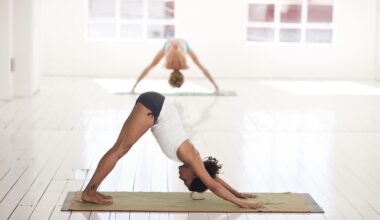Glute Bridges: Bodyweight Exercise Tutorial for Strong Hips
The glute bridge is an essential exercise in bodyweight training, particularly for those aiming to strengthen their hips. It primarily targets the gluteus maximus, hamstrings, and lower back while promoting stability. By engaging the core, this movement also aid in improving overall body awareness and form. Plus, it can be performed almost anywhere, requiring no equipment other than your body and a comfortable surface. Before starting, ensure you have adequate space to maintain proper form. Effective movement begins with mastering the basics before advancing to variations. Implementing glute bridges into your routine can enhance not only strength but also athletic performance. By focusing on muscle engagement, you can develop the necessary foundation for various physical activities, such as running and cycling. Proper technique is crucial for maximizing benefits while minimizing the risk of injury. So understanding the correct posture and foot placement is important. Next, we will discuss key steps to perform a successful glute bridge exercise.
Steps to Perform the Perfect Glute Bridge
To execute a glute bridge correctly, start by lying flat on your back, with your knees bent and feet placed hip-width apart. Your heels should be relatively close to your glutes, allowing for effective lifting. Once you’re in position, engage your core and press through your heels, lifting your hips towards the ceiling. The goal is to create a straight line from your shoulders to your knees at the top of the movement. Once in this position, squeeze your glutes tightly and hold for a brief moment before lowering your hips back down. Be mindful of your breathing throughout this exercise; inhale as you prepare and exhale as you lift. It’s crucial to keep tension on your glutes without overarching your back. You should feel activation through your hips, not discomfort in your lower back. Moreover, performing glute bridges regularly can lead to improved muscle tone and posture. Adding variety, such as single-leg glute bridges, can further challenge strength. This will engage stabilizers for a complete workout. Let’s delve into some variations of this exercise.
Glute Bridge Variations to Increase Intensity
Once you feel comfortable with the basic glute bridge, consider exploring several variations to elevate the challenge. One popular option is the single-leg glute bridge, which involves raising one leg while lifting your hips. By shifting your body weight onto one leg, you significantly increase the intensity, forcing your core and stabilizer muscles to engage more effectively. Another variation includes the elevated glute bridge, where your feet are placed on an elevated surface such as a bench. This shift in angle alters the dynamics of the exercise, allowing for greater range of motion and deeper muscle engagement. You can also add resistance using a resistance band around your knees or by holding a weight plate across your hips. Each variation targets different muscle fibers, providing a comprehensive workout. Additionally, exploring tempo variations, such as holding the bridge position for longer, can help build endurance and strength. Incorporating these variations will not only enrich your routine but also promote continual progression. Remember to maintain proper form throughout, ensuring each movement remains controlled for maximum benefits.
While glute bridges are beneficial for various fitness levels, it`s essential to focus on safety to prevent injury. Many people tend to use momentum rather than muscle engagement to perform the lift, which can lead to an improper activation of glute muscles. To ensure proper technique, always keep your core engaged and avoid arching your back during the lift. Instead, focus on squeezing through the glutes at the top of the motion. If you experience discomfort in your lower back, reevaluate your form. It may indicate a need to strengthen your core or adjust your foot placement. Also, consider gradually increasing the difficulty by reducing rest time between sets or exploring added weights. Additionally, resting adequately between workouts ensures muscle recovery while preventing fatigue. Prioritize quality over quantity to truly reap the benefits of glute bridges. As you improve, remember to incorporate these exercises into a balanced workout regimen that includes strength training, cardio, and flexibility training. This holistic approach will optimize your overall gains and support your fitness journey.
Common Mistakes to Avoid While Performing Glute Bridges
As with any exercise, perfecting your form during glute bridges is essential to avoid common mistakes. One frequent error occurs when individuals allow their knees to cave inward as they lift. Ensure that your knees remain aligned with your toes throughout the movement to promote joint stability. Additionally, many people tend to push through their toes instead of their heels, which drastically reduces the effectiveness of the exercise. Concentrate on pressing through your heels during the lift to fully engage your glutes. Another mistake is failing to fully extend at the top of the bridge; this prevents you from achieving maximum activation. Always hold the bridge position for a second to reinforce mind-muscle connection. Moreover, forgetting to hold your core tight can lead to unnecessary strain on your lower back. Maintaining a neutral spine throughout is imperative for benefiting from glute bridges. Lastly, ensure your movements remain slow and controlled; rapid lifting may lead to compromised form and potential injury. By being mindful of these tips, you can refine your technique and maximize your results.
To track your progress effectively, consider integrating glute bridges into a comprehensive workout log. Document each session, including reps, sets, and any variations you attempted. This will not only help maintain motivation but also enable you to identify patterns in your performance. You may find that specific variations yield better results or that you need to adjust your form. Adding glute bridges to workouts two to three times weekly allows for optimal muscle growth without risking overtraining. Additionally, consult with a fitness professional if uncertain about your form or interested in learning advanced techniques. Many experts recommend pairing glute bridges with additional lower body workouts such as squats or lunges for an overall lower body strength program. You can also incorporate upper body movements to create a balanced full-body workout. Ultimately, consistency and dedication to your training will determine your success in achieving stronger hips. With time, dedication, and proper technique, glute bridges will become a powerful ally in your fitness journey.
Conclusion: Strengthening Hips for Better Performance
In conclusion, glute bridges serve not only as a foundation for strengthening your hips but also equip you with the stability necessary for various physical activities. By utilizing this bodyweight exercise in your weekly routine, you can reap numerous benefits, including improved sport performance and enhanced posture. When performed correctly, glute bridges can help alleviate lower back pain, as strong glutes support the spine and improve your alignment. Whether you are a beginner seeking to build strength or an advanced athlete aiming to further refine your skills, glute bridges can be easily adapted to fit your needs. Remember that variations and modifications play a crucial role in keeping your training exciting and effective. Overall, the glute bridge is a simple yet transformative exercise that can yield significant results. As you progress, don’t hesitate to experiment with different variations or consult a trainer for added tips. With focus and commitment, your hips will be stronger than ever, supporting every movement you do both in the gym and everyday life.
Keep exploring and enjoy your workouts as you continue mastering these techniques for the best results. Personalize your training and find what works best for you on your fitness journey, embracing the positive changes along the way. With diligence and commitment, your glute bridge prowess will sharpen. Stay focused on achieving those strong hips, and you will see notable improvements and gains involuntary strength and performance. Make sure you celebrate every milestone—whether big or small—on your road to deeper hip strength. Whether training for a competitive sport or pursuing fitness for health benefits, effective core and hip training can lead to success. As you witness your progress, you’ll discover how much more versatile your body can become. Ultimately, glute bridges are more than just an exercise; they’re a pathway to functional strength and improved athletic performance. So, embrace this incredible exercise as part of your routine. Doing so will not only enhance your glutes but also transform your overall physique, making you feel stronger and more capable than before.


